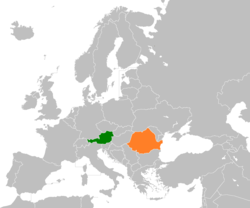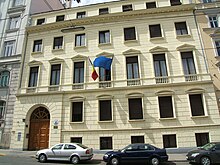Austro-Romanian relations

|
|
|
|
|
| Austria | Romania |
The diplomatic relations between the Republic of Austria and Romania were largely determined and limited by the global political environment. Generally good cooperation has always been in the interests of Romanian and Austrian foreign policy . For Bucharest , Vienna acted as a political transit point to the west and, from the Austrian point of view, Romania was politically close due to a common history of some parts of Romania (especially Banat , Transylvania and Bukovina ) going back several centuries .
history
1920 to 1938
After the dissolution of the Austro-Hungarian monarchy , diplomatic relations between the Republic of Austria and Romania at legation level were established on August 27, 1920. Due to the annexation to Nazi Germany , however, these were interrupted again in 1938.
1945 to 1989
The first accredited political representative of Austria in Romania after the Second World War was Legation Councilor Dr. Herbert Schmidt, who held the title of Consul General in Romania . He presented the then Foreign Minister Gheorghe Tătărescu with his letter of introduction on October 5, 1947. The Austrian delegation in Bucharest remained a purely political representation until 1955 and, at Romania's request, was not elevated to the rank of embassy or embassy. The reason for this negative attitude was the legally unresolved situation in Austria up to the restoration of state independence in 1955 .
An evaluation of relations with Austria carried out on the Romanian side between 1944 and 1954 remained largely in line with the stereotypes prevailing at the time. According to this, Austria would at least allow fascist, anti-Romanian tendencies on its own territory and be subject to the hegemony of the USA on foreign policy issues . The elevation of the Austrian representation to the rank of embassy under the charge of the charge, envoy Dr. Albert Filz, after signing the State Treaty in 1955 , should therefore be seen more as a “symbolic act”. After that, it took some personnel changes in the top management of both states before relations began to thaw. On the Romanian side, the appointment of Ion Gheorghe Maurer as Prime Minister and Corneliu Mănescu as Foreign Minister was groundbreaking. On the Austrian side, Bruno Kreisky, as Foreign Minister, was able to positively influence bilateral relations.
The phase of good diplomatic relations in the 1960s was marked by the signing of the Austro-Romanian property treaty in 1963 by Bruno Kreisky . The subsequent consolidation of contractual relationships was accompanied by the elevation of the Austrian legation to the rank of embassy in 1963. From this point on, a lively exchange of visits developed at the highest political level, with the visit of the then Austrian President Franz Jonas in 1969 and the return visit of Nicolae Ceaușescu in Vienna in 1970 marked the protocol climax.
In foreign policy matters, Romania was able to benefit for a long time from the fact that the US-dominated West could do anything that would weaken the Soviet Union . In this context, it was of secondary importance that Nicolae Ceaușescu established an increasingly authoritarian regime as long as Romania remained independent of the Soviet Union to a certain extent. Austrian diplomacy initially found it difficult to correctly assess this phenomenon. Due to the worsening situation in the 1980s under Ceauşescu and the subsequent isolation of Romania, diplomatic relations with Austria also experienced stagnation.
Since 1989
After the collapse of the communist regime, relations initially remained reserved, as Austria assessed the government under President Ion Iliescu as largely neo-communist. In November 1996, the success of the Democratic Convention in the parliamentary elections and the election of Emil Constantinescu as president gave hope for political reforms and economic opening. The EU course followed by Romania and the accession negotiations officially started in 2000 intensified diplomatic and economic relations. Although the hoped-for reforms in Romania stalled due to internal power games and frequent changes at ministerial level, Austria advanced to become one of the most important foreign investors in the country and supported Romania's accession to the European Union in 2007. Since then, both sides have been working, not least within the framework of the European one Cohesion policy and in projects such as the EU strategy for the Danube region.
The last state visit took place on March 23, 2009 in Vienna. Federal President Heinz Fischer received the Romanian President Traian Băsescu with military honors . Ten years earlier, on March 18 and 19, 1999, Federal President Thomas Klestil and a delegation consisting of Economics Minister Hannes Farnleitner , Interior Minister Karl Schlögl and representatives from companies and the Austrian Chamber of Commerce visited the Romanian capital.
Official and cultural cooperation
Representations of the Republic of Austria in Romania
- Austrian Embassy in Bucharest
- Honorary consulates in Timisoara and Sibiu
Representations of Romania in Austria
- Romanian Embassy in Vienna
- Permanent representation of Romania at international organizations in Vienna
- Honorary consulates in Eisenstadt, Linz, Graz, Salzburg and Klagenfurt am Wörthersee
Austrian-Romanian cultural cooperation
- Romanian-Austrian company with offices in Vienna and Bucharest
- Austria libraries in Bucharest, Klausenburg, Iaşi and Timisoara
- ÖAD lectureships in Bucharest, Sibiu, Cluj, Iaşi and Timisoara
- Romanian Cultural Institute Vienna
- Austrian Cultural Forum Bucharest
Romanian-Austrian town twinning
(no guarantee of completeness)
- Judenburg (Styria) - Siret / Sereth (Suceava district)
- Graz ( Styria ) - Timișoara ( Timiș District )
- Klagenfurt (Carinthia) - Sibiu / Hermannstadt (Sibiu District)
- Schwaz (Tyrol) - Satu Mare / Sathmar (Satu Mare district)
- Linz (Upper Austria) - Braşov / Kronstadt (Braşov District)
See also
Web links
- Austrian Embassy Bucharest
- Austrian foreign trade in Romania
- Austrian Cultural Forum Bucharest
- Romanian Cultural Institute Vienna
- Romanian Ministry of Foreign Affairs
- Romanian Embassy Vienna
- Austria libraries
- ÖAD lectureships in Romania
- Romanian-Austrian Society

